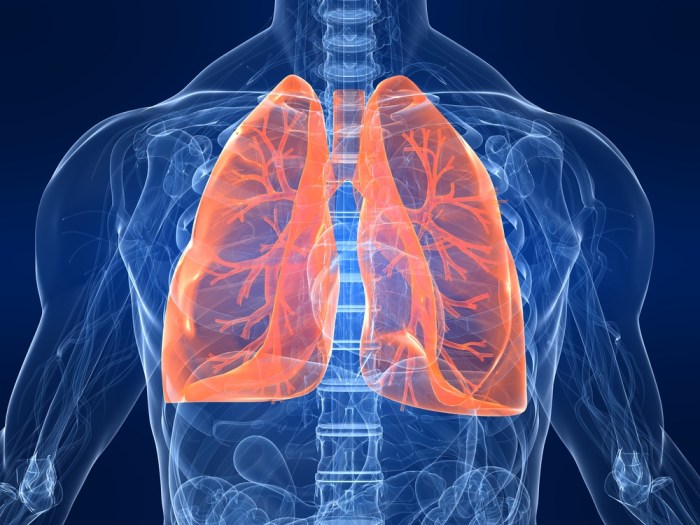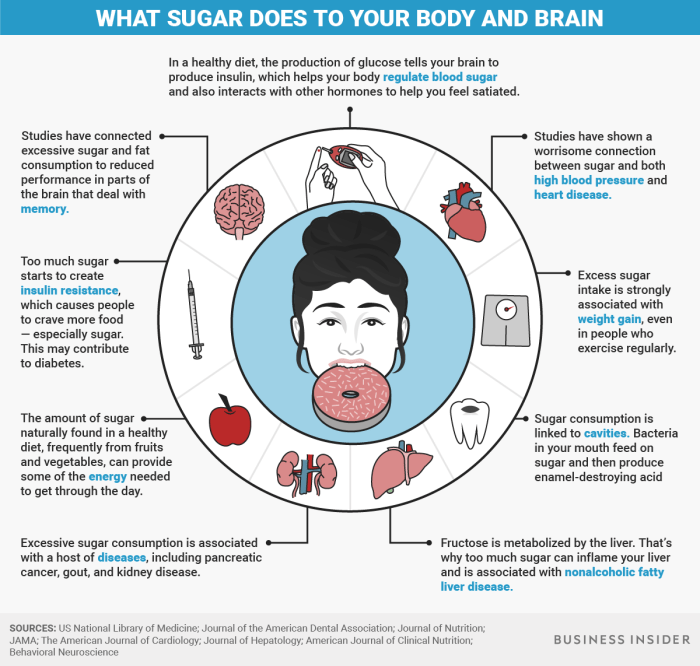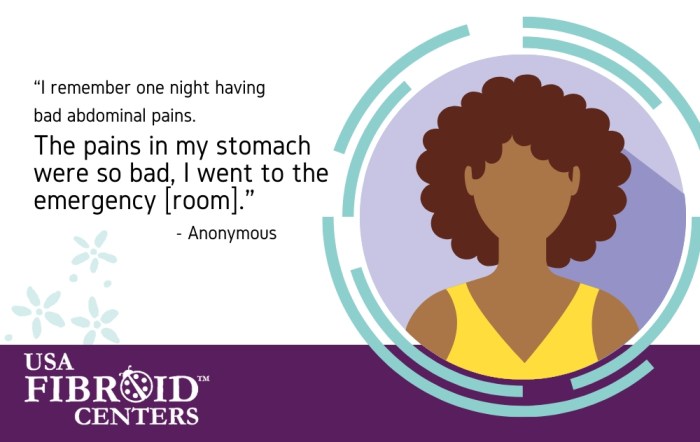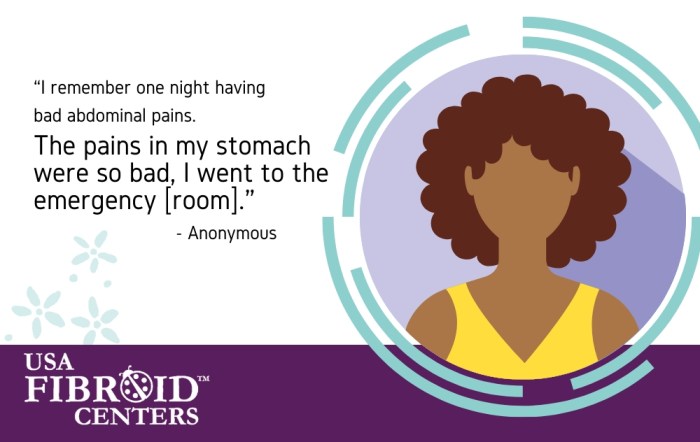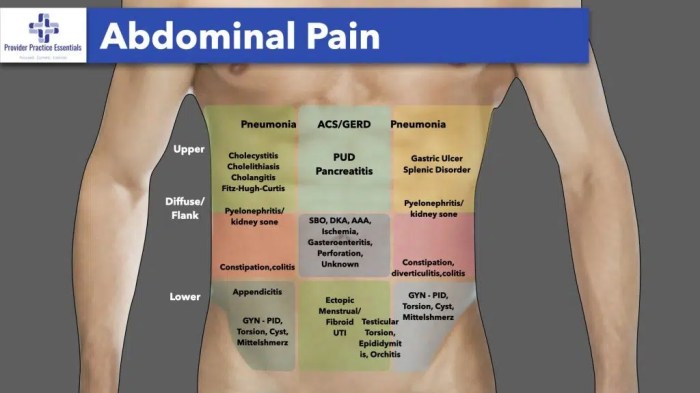Lung cancer with an EGFR mutation is a specific type of lung cancer driven by abnormal growth signals. This condition requires a nuanced understanding of the EGFR protein’s role in healthy lung cells, how mutations disrupt this function, and the diverse mutations themselves. Understanding the different types of EGFR mutations, along with their prevalence and clinical presentations, is critical for effective diagnosis and treatment.
This guide delves into the diagnostic journey, exploring the various procedures used to identify EGFR mutations. We’ll also examine the rationale behind each procedure and compare the sensitivity and specificity of different diagnostic tests. Early detection is crucial, and potential biomarkers play a vital role. Furthermore, we’ll explore the importance of accurate diagnosis for effective treatment planning.
Introduction to Lung Cancer with EGFR Mutation
Lung cancer, a devastating disease, is often categorized by the specific genetic alterations driving its development. One significant subtype involves mutations in the epidermal growth factor receptor (EGFR) gene. Understanding these mutations is crucial for diagnosis, treatment, and prognosis. EGFR mutations are frequently encountered in non-small cell lung cancer (NSCLC), particularly in individuals with a history of smoking.The epidermal growth factor receptor (EGFR) is a protein crucial for normal lung cell function.
It acts as a critical communication hub, receiving signals from other cells that regulate growth, division, and survival. In a healthy lung, EGFR activity is tightly controlled, ensuring appropriate cell responses. However, mutations in the EGFR gene can disrupt this delicate balance, leading to uncontrolled cell growth and ultimately, the development of lung cancer.
Role of EGFR in Normal Lung Cell Function
EGFR plays a pivotal role in mediating cellular signaling pathways essential for regulating growth, differentiation, and survival of lung cells. It facilitates communication between cells, responding to signals that promote or inhibit these processes. This tight regulation is vital for maintaining healthy lung tissue architecture. Disruptions to this signaling cascade can have profound consequences, contributing to uncontrolled cell proliferation and ultimately, tumorigenesis.
EGFR Mutations and Uncontrolled Cell Growth
EGFR mutations act by activating the EGFR protein, even without the presence of external growth signals. This constitutive activation triggers a cascade of intracellular events, leading to uncontrolled cell growth, division, and survival. These uncontrolled processes result in the formation of tumors, characteristic of lung cancer. Clinically, this uncontrolled growth translates to the formation of tumors, a hallmark of lung cancer.
Common Types of EGFR Mutations
Several specific EGFR mutations are frequently associated with lung cancer. These mutations can impact different regions of the EGFR protein, leading to varied degrees of activation and functional consequences. These mutations typically manifest in exons 18, 19, and 20 of the EGFR gene, each associated with different clinical presentations and response patterns to targeted therapies. Understanding these specific mutations is critical for personalized treatment strategies.
Summary of EGFR Mutation Types
| Mutation Type | Prevalence | Typical Clinical Presentation |
|---|---|---|
| Exon 19 Deletion | Common | Often responds well to EGFR tyrosine kinase inhibitors (TKIs), frequently exhibiting rapid tumor shrinkage and improved survival outcomes. |
| Exon 21 L861Q Substitution | Moderately common | Generally responds to EGFR TKIs, but the response rate might be slightly lower compared to exon 19 deletions. Clinical outcomes may vary based on the specific mutation and individual patient characteristics. |
| Exon 20 Insertion | Less common | Responses to EGFR TKIs can be variable, and the clinical course may be less predictable compared to the other common mutations. Careful monitoring and individualized treatment approaches are necessary. |
Diagnostic Methods and Procedures
Identifying EGFR mutations in lung cancer is crucial for personalized treatment. Accurate diagnosis allows for the selection of targeted therapies, potentially improving outcomes and reducing unnecessary treatments. This section delves into the common diagnostic procedures used to identify EGFR mutations, emphasizing the rationale behind each and the importance of accurate results for effective treatment planning.
Common Diagnostic Procedures
Various methods are employed to detect EGFR mutations in lung cancer. These include polymerase chain reaction (PCR)-based assays, immunohistochemistry (IHC), and next-generation sequencing (NGS). Each method has its strengths and limitations, influencing its suitability for specific situations.
Polymerase Chain Reaction (PCR)-based Assays
PCR-based assays are frequently used for EGFR mutation detection. These assays amplify specific DNA sequences associated with EGFR mutations, enabling precise identification. The rationale is that the presence or absence of specific mutations correlates with the patient’s potential response to targeted therapies.
Immunohistochemistry (IHC)
IHC is another method employed to identify EGFR mutations. It utilizes antibodies to detect the presence of mutated EGFR protein in tissue samples. The rationale is that the presence of a specific mutated protein often suggests a likelihood of a targeted therapy response.
Next-Generation Sequencing (NGS)
NGS is a powerful tool for comprehensive genomic analysis, including the identification of EGFR mutations. It simultaneously examines multiple genes, offering a broader view of the patient’s tumor profile. The rationale behind NGS is its ability to detect a wider array of mutations beyond just EGFR, providing a more complete picture of the tumor’s characteristics for tailored treatment strategies.
Comparison of Diagnostic Tests
| Diagnostic Test | Sensitivity | Specificity | Rationale |
|---|---|---|---|
| PCR-based Assays | High | High | Precise amplification and detection of specific mutations. |
| IHC | Moderate | Moderate | Visual detection of mutated protein; useful in combination with other methods. |
| NGS | Very High | Very High | Comprehensive genomic analysis; identifies multiple mutations. |
Potential Biomarkers for Early Detection
Identifying potential biomarkers for early detection of EGFR mutations is an active area of research. While not yet widely used in clinical practice, several potential biomarkers are being explored, including circulating tumor DNA (ctDNA) and exosomes. These could allow for earlier detection and intervention, potentially improving outcomes.
Importance of Accurate Diagnosis
Accurate diagnosis of EGFR mutations is paramount in treatment planning. Matching patients with appropriate targeted therapies based on the presence or absence of these mutations can significantly impact their prognosis. A patient with an EGFR mutation may respond well to specific drugs, while a patient without the mutation may not benefit from these therapies. Therefore, precise identification is crucial for effective and personalized treatment.
Treatment Strategies
Lung cancer with an EGFR mutation presents a unique opportunity for targeted therapy. These treatments, specifically designed to exploit the genetic abnormality, often lead to impressive responses and improved survival rates compared to traditional chemotherapy. Understanding the mechanisms behind these therapies is crucial for comprehending their efficacy and potential side effects.Targeted therapies for EGFR-mutated lung cancer are a significant advancement in oncology.
They represent a shift from treating the entire body with chemotherapy to precisely targeting the mutated EGFR protein, which drives tumor growth in these patients. This targeted approach minimizes harm to healthy cells while maximizing the impact on cancerous cells.
Overview of Treatment Options
Various targeted therapies are available for patients with EGFR-mutated lung cancer. These therapies primarily focus on inhibiting the EGFR protein’s ability to signal and drive tumor growth. The most common types of targeted therapies include tyrosine kinase inhibitors (TKIs). These medications interfere with the EGFR protein’s signaling pathway, preventing it from activating and promoting uncontrolled cell division.
Mechanisms of Action of Targeted Therapies
EGFR-targeted therapies work by binding to the EGFR protein, specifically to the ATP-binding pocket within the tyrosine kinase domain. This binding prevents the protein from activating, thus inhibiting downstream signaling pathways that promote cell growth and division. This targeted inhibition can halt the uncontrolled proliferation of cancer cells, leading to tumor shrinkage or even remission in some cases.
Learning about lung cancer with an EGFR mutation has been a real eye-opener. It’s fascinating how different types of cancer can impact your life. Recently, I’ve also been reflecting on my own health journey, specifically my visit with a hidradenitis suppurativa specialist. Your visit hidradenitis suppurativa helped me understand the importance of proactive care and support networks.
While different, both experiences highlight the need for ongoing education and self-advocacy when facing a health challenge, especially regarding lung cancer with an EGFR mutation.
How EGFR-Targeted Therapies Inhibit Tumor Growth
EGFR-targeted therapies, by binding to the EGFR protein’s ATP-binding site, effectively block the activation of downstream signaling pathways that promote tumor growth. This prevents the uncontrolled cell division and proliferation characteristic of cancer.
The precise inhibition of EGFR signaling halts the cascade of events that drive tumor progression, leading to a reduction in tumor size and a slowing or stopping of tumor growth.
Comparison of Different EGFR-Targeted Therapies
Different EGFR-targeted therapies vary in their specific mechanisms of action and potential side effects. Some therapies, like gefitinib and erlotinib, are first-generation TKIs, while others, like osimertinib, are newer, third-generation TKIs, designed to overcome resistance mechanisms. The choice of therapy depends on factors such as the specific EGFR mutation, the patient’s overall health, and prior treatment history.
Potential Side Effects of These Treatments
While EGFR-targeted therapies are highly effective, they can also cause side effects. Common side effects may include skin rash, diarrhea, fatigue, and nausea. Less common but potentially more serious side effects may include pneumonia or other infections. Regular monitoring by a healthcare team is essential to manage these side effects and ensure optimal patient care.
Table of Targeted Therapies
| Targeted Therapy | Mechanism of Action | Common Side Effects |
|---|---|---|
| Gefitinib | Inhibits EGFR tyrosine kinase activity. | Skin rash, diarrhea, fatigue, nausea, and rarely pneumonitis. |
| Erlotinib | Inhibits EGFR tyrosine kinase activity. | Skin rash, diarrhea, fatigue, nausea, and rarely pneumonitis. |
| Osimertinib | Inhibits EGFR tyrosine kinase activity, with greater potency against T790M mutations. | Skin rash, diarrhea, fatigue, nausea, and rarely pneumonitis. Potential for more severe rash compared to other therapies. |
| Afatinib | Inhibits EGFR tyrosine kinase activity. | Skin rash, diarrhea, fatigue, and nausea. |
Prognosis and Patient Management
Navigating the path of lung cancer with an EGFR mutation requires a comprehensive understanding of prognosis and proactive management. Early diagnosis and appropriate treatment strategies significantly impact the patient’s journey, and understanding the factors influencing outcomes is crucial for informed decision-making. The specific EGFR mutation type, the stage of the cancer, and the patient’s response to treatment all play critical roles in determining the overall outlook.This journey necessitates a collaborative approach, involving a multidisciplinary team.
This team-based approach ensures that patients receive holistic care, addressing not only the cancer itself but also the potential complications and side effects of treatment. Supportive care plays a vital role in enhancing quality of life and managing the challenges associated with the disease and its treatment.
Prognosis of EGFR-Mutated Lung Cancer
The prognosis for lung cancer patients with EGFR mutations is generally favorable compared to other lung cancer types. Early detection and appropriate targeted therapy often lead to significant tumor shrinkage and improved survival rates. However, individual outcomes vary based on several key factors.
Factors Influencing Prognosis
Several factors significantly influence the prognosis of patients with EGFR-mutated lung cancer. The stage of the cancer at diagnosis, the specific EGFR mutation type, and the patient’s response to treatment are all critical determinants. Other factors like overall health status, age, and adherence to treatment also contribute to the individual outcome.
| Factor | Description | Impact on Prognosis |
|---|---|---|
| Stage of Cancer | Early-stage cancers (localized) have a better prognosis than advanced-stage cancers (metastatic). | Early detection and treatment improve chances of long-term survival. |
| EGFR Mutation Type | Specific EGFR mutations (e.g., exon 19 deletion, exon 21 L861Q) may influence response to treatment and long-term outcomes. | Some mutations are more responsive to specific targeted therapies than others. |
| Response to Treatment | Complete or partial response to initial treatment indicates a better chance of long-term survival. | Rapid and sustained response to targeted therapy is associated with favorable outcomes. |
| Overall Health Status | Pre-existing conditions and overall health of the patient can influence the response to treatment and long-term outcomes. | Compromised health status can increase treatment challenges and impact prognosis. |
| Age | Age of the patient can influence the patient’s ability to tolerate treatment and overall health status. | Elderly patients may experience more treatment-related side effects and have a potentially more complex treatment plan. |
| Adherence to Treatment | Consistent and proper adherence to prescribed treatment is crucial for optimal outcomes. | Missed or inadequate treatment can negatively impact response and survival rates. |
Multidisciplinary Care
A multidisciplinary approach is essential for optimal patient management. A team comprising oncologists, pulmonologists, radiotherapists, pathologists, and other specialists work collaboratively to develop a comprehensive treatment plan. This integrated approach ensures that patients receive personalized care tailored to their specific needs and circumstances. This collaboration leads to better outcomes by addressing the various aspects of the disease and its treatment.
Potential Complications and Management Strategies
While targeted therapies for EGFR-mutated lung cancer are highly effective, potential side effects can arise. These include skin reactions, fatigue, nausea, and diarrhea. Managing these side effects requires careful monitoring and supportive care, potentially involving medication adjustments and lifestyle modifications. Understanding the potential complications is critical for proactive management.
Supportive Care Options
Supportive care is integral to enhancing the quality of life for patients with EGFR-mutated lung cancer. This encompasses various aspects, including nutritional counseling, pain management, psychological support, and rehabilitation programs. These interventions aim to alleviate the physical and emotional burdens associated with the disease and its treatment, enabling patients to maintain a positive outlook and continue their daily activities.
Tailored support programs are crucial for each patient to manage their unique challenges.
Research and Future Directions
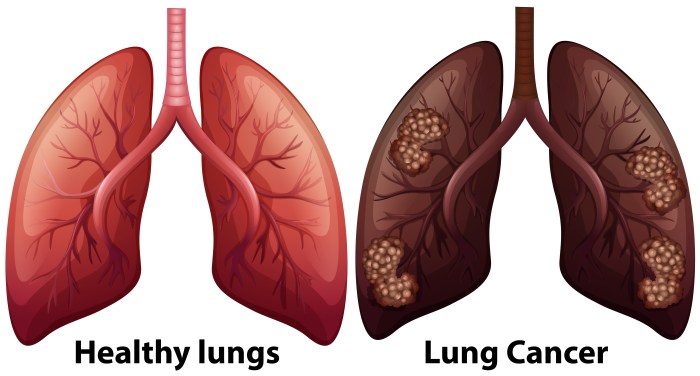
The journey of understanding and treating EGFR-mutated lung cancer is an ongoing one, driven by a relentless pursuit of improved outcomes. Current research is focused on identifying novel therapeutic targets and developing more personalized approaches, ultimately aiming to enhance treatment efficacy and minimize side effects. This exploration promises to reshape the landscape of lung cancer care, offering hope for patients and their families.
Novel Therapies and Strategies
Research into EGFR-mutated lung cancer is actively exploring a range of novel therapies beyond the standard tyrosine kinase inhibitors (TKIs). Immunotherapy is emerging as a promising avenue, leveraging the body’s own immune system to combat cancer cells. Checkpoint inhibitors, for instance, can potentially enhance the anti-tumor response by releasing the brakes on the immune system. Targeted therapies are also being developed to address specific vulnerabilities within the tumor microenvironment, offering more precise and potentially less toxic treatments.
Combination therapies, combining TKIs with other agents like immunotherapy or chemotherapy, are being investigated to achieve synergistic effects and improve response rates.
Learning about lung cancer with an EGFR mutation can be overwhelming, but it’s important to stay informed. While there’s no magic bullet for this condition, exploring alternative approaches like home remedies for ear infections can sometimes provide relief from the side effects. For example, natural remedies can help alleviate some symptoms associated with treatment, and resources like home remedies ear infections offer helpful insights.
Ultimately, the best course of action for lung cancer with an EGFR mutation should be discussed with your healthcare provider.
Ongoing Clinical Trials
Numerous clinical trials are investigating the efficacy and safety of novel therapies for EGFR-mutated lung cancer. These trials often evaluate different combinations of drugs, dosages, and schedules, and assess the long-term effects on patients’ overall health.
| Trial Name | Study Design | Objectives |
|---|---|---|
| Example Trial 1 | Phase III, randomized, controlled trial | To compare the efficacy and safety of a novel immunotherapy agent combined with standard TKI treatment versus standard TKI treatment alone in patients with EGFR-mutated lung cancer who have progressed after first-line TKI therapy. |
| Example Trial 2 | Phase II, open-label study | To evaluate the tolerability and anti-tumor activity of a novel targeted therapy in combination with chemotherapy in patients with EGFR-mutated lung cancer who have not responded to prior therapies. |
| Example Trial 3 | Phase I, dose-escalation study | To determine the maximum tolerated dose and preliminary efficacy of a new targeted therapy in patients with EGFR-mutated lung cancer. |
Long-Term Effects of Treatment
The long-term effects of EGFR-mutated lung cancer treatment, particularly the long-term side effects of the therapies, require further investigation. Studies are needed to comprehensively understand the impact of these treatments on patients’ quality of life and overall health over time. The development of long-term follow-up strategies and supportive care protocols is crucial to mitigate the potential adverse consequences of treatment.
For instance, monitoring for the development of secondary cancers and cardiovascular complications is essential to ensure comprehensive patient management.
Areas Requiring Further Research
Understanding the complex interplay between EGFR mutations, tumor heterogeneity, and the tumor microenvironment is crucial for developing more effective and personalized therapies. Further research is needed to identify biomarkers that can predict treatment response and identify patients who are most likely to benefit from specific therapies. Developing strategies to prevent or mitigate treatment-related side effects, particularly long-term side effects, is also a high priority.
Investigating the role of genetic factors and lifestyle choices in influencing treatment outcomes and long-term health is critical to creating a more comprehensive understanding of this complex disease.
Patient Support and Resources: Lung Cancer With An Egfr Mutation
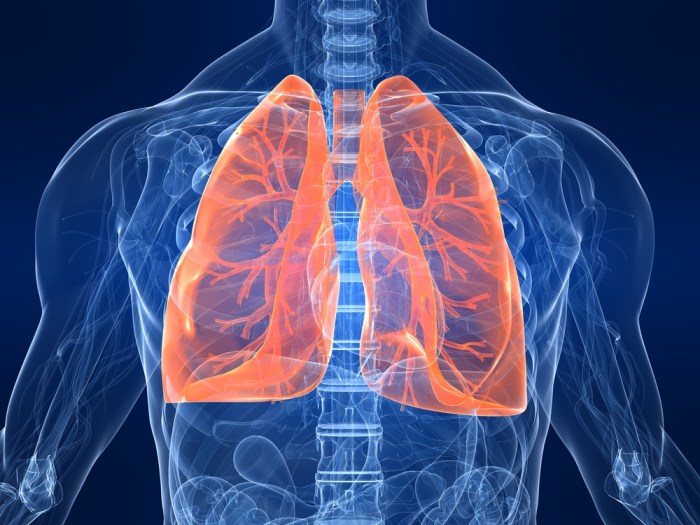
Navigating a lung cancer diagnosis, particularly one with an EGFR mutation, can be overwhelming. Beyond the medical treatment, patients and families require comprehensive support to cope with the emotional, practical, and informational challenges. This section highlights crucial resources and strategies to empower patients and facilitate a smoother journey through this difficult time.
Understanding lung cancer with an EGFR mutation often involves looking at the building blocks of the disease. These mutations can lead to uncontrolled cell growth, but where do these abnormal cells come from? They develop from precancerous cells, which are essentially cells that have started down a path towards becoming cancerous. Learning about these precancerous cells is key to understanding the progression of lung cancer with an EGFR mutation.
Knowing what are precancerous cells helps us identify potential issues early and improve treatment strategies. This understanding is crucial for effective management and prevention strategies for lung cancer with an EGFR mutation. what are precancerous cells to learn more about the crucial role they play.
Patient Support Organizations
Patient support organizations play a vital role in providing information, emotional support, and practical guidance to individuals diagnosed with lung cancer. These organizations often have dedicated staff, volunteer networks, and extensive online resources. Finding the right support can make a significant difference in managing the emotional toll of the disease and treatment.
- The American Lung Association offers a wide array of services, including educational materials, support groups, and advocacy efforts. They provide crucial information on lung cancer, including different types, treatment options, and potential side effects. Their website also offers resources for caregivers and families.
- The National Cancer Institute (NCI) is a valuable resource, providing detailed information on lung cancer, including research updates, treatment protocols, and clinical trials. Their website and publications are excellent tools for staying informed about the latest developments in lung cancer care.
- The American Society of Clinical Oncology (ASCO) offers expert information and resources on cancer treatment, including lung cancer. Their website provides detailed information on treatment options, side effects, and clinical trials. They also host educational seminars and conferences.
Emotional Support for Patients and Families
The emotional impact of a lung cancer diagnosis can be profound, affecting not only the patient but also family members. It’s crucial to recognize and address the emotional needs of both the patient and their loved ones. Seeking professional counseling, joining support groups, and engaging in activities that promote emotional well-being are vital components of comprehensive care. Support groups provide a safe space to share experiences, receive encouragement, and learn coping strategies from others facing similar challenges.
Online Resources and Support Groups
Online resources and support groups offer a valuable avenue for connecting with others who understand the challenges of living with lung cancer. These platforms provide a sense of community and allow patients to share experiences, ask questions, and receive emotional support.
- Many patient support organizations have online forums and communities where individuals can connect with others, share experiences, and find encouragement. These online spaces offer a virtual extension of the support networks available through traditional organizations.
- Social media groups can be valuable, offering opportunities for support and sharing information. However, it is essential to be cautious about the credibility of information shared on these platforms. Always verify information with trusted sources.
Patient Education and Empowerment
Empowering patients with knowledge and understanding is essential for navigating the complexities of lung cancer treatment. Patients should feel empowered to ask questions, understand their options, and participate actively in their care. This includes gaining a comprehensive understanding of their diagnosis, treatment options, potential side effects, and the importance of adhering to treatment plans.
Navigating the Healthcare System
Effective navigation of the healthcare system is crucial for patients with lung cancer. This includes understanding the roles of different healthcare professionals, such as oncologists, nurses, and social workers. It also involves comprehending the insurance process, managing appointments, and understanding the various treatment options available.
Table of Patient Support Organizations
| Organization | Contact Information | Services Provided |
|---|---|---|
| American Lung Association | (Phone number) [Website address] |
Educational materials, support groups, advocacy efforts, information on lung cancer types, treatment options, and side effects; resources for caregivers and families. |
| National Cancer Institute (NCI) | (Phone number) [Website address] |
Detailed information on lung cancer, research updates, treatment protocols, clinical trials; resources on various types of cancer. |
| American Society of Clinical Oncology (ASCO) | (Phone number) [Website address] |
Expert information and resources on cancer treatment, including lung cancer; treatment options, side effects, clinical trials; educational seminars and conferences. |
Illustrative Case Studies
Understanding the diverse landscape of lung cancer with EGFR mutations requires exploring real-world scenarios. Case studies provide valuable insights into the diagnostic process, treatment approaches, and long-term outcomes. These examples, while hypothetical, reflect the complexity and variability often encountered in clinical practice.
Case Study 1: Young-Onset Lung Cancer
A 35-year-old female presents with persistent cough and shortness of breath. A chest X-ray reveals a suspicious nodule. Bronchoscopy and subsequent biopsy confirm non-small cell lung cancer (NSCLC) with an EGFR mutation. Initial diagnostic testing involves genetic sequencing to confirm the mutation type and its potential impact on treatment selection. Given her age and the presence of an EGFR mutation, targeted therapy with an EGFR tyrosine kinase inhibitor (TKI) is considered a primary treatment option.
The patient responds well to the treatment, experiencing a significant reduction in tumor burden. However, after several months, resistance emerges, necessitating a change in treatment strategy. The patient continues to receive care and monitor her response to new treatment options. A multidisciplinary approach involving oncologists, pulmonologists, and other specialists is crucial for optimal management.
“Early diagnosis and targeted therapy, while effective in some cases, can face challenges with potential resistance development, emphasizing the need for continuous monitoring and individualized treatment adjustments.”
Case Study 2: Locally Advanced Disease
A 60-year-old male smoker presents with a history of cough and chest pain. Imaging reveals a large lung tumor extending into surrounding tissues. Thorough diagnostic workup, including CT scans, PET scans, and biopsy, confirms the presence of NSCLC with an EGFR mutation. The tumor’s location and size necessitate a multi-modality approach to treatment. The patient is initially treated with chemotherapy to shrink the tumor, followed by surgery to remove the affected lung tissue.
Post-surgery, targeted therapy with an EGFR TKI is initiated to prevent recurrence and control the disease. The patient experiences a significant improvement in lung function and quality of life. However, due to the advanced nature of the disease, long-term monitoring and regular follow-up are crucial.
“Locally advanced disease requires a combination of therapies, such as chemotherapy and surgery, alongside targeted therapy. While successful outcomes are possible, the complex nature of the disease underscores the need for a multidisciplinary approach to treatment.”
Case Study 3: Metastatic Disease, Lung cancer with an egfr mutation
A 75-year-old female with a history of smoking experiences worsening shortness of breath and fatigue. Imaging reveals lung cancer with distant metastases to the liver and brain. Genetic testing confirms an EGFR mutation. Given the metastatic nature of the disease, the focus of treatment shifts towards palliative care and symptom management. The patient is initially treated with an EGFR TKI, demonstrating a modest response.
However, the disease progresses, and additional treatment options, such as immunotherapy or combination therapies, are explored. The patient receives supportive care to manage her symptoms and improve her overall quality of life. The treatment plan is adjusted regularly based on the patient’s response and the progression of the disease.
“Metastatic disease presents unique challenges, with a focus on palliative care and symptom management alongside ongoing treatment options. Personalized treatment strategies and close monitoring are crucial to maximizing quality of life.”
Importance of Individualized Treatment Plans
The diverse presentations of lung cancer with EGFR mutations necessitate personalized treatment plans. Factors such as the specific EGFR mutation type, the stage of the disease, the patient’s overall health, and preferences play a significant role in shaping the treatment strategy. This individualized approach maximizes the potential benefits of treatment while minimizing adverse effects. A team of healthcare professionals, including oncologists, pulmonologists, radiotherapists, and genetic counselors, work collaboratively to create a comprehensive treatment plan tailored to the specific needs of each patient.
End of Discussion
In conclusion, lung cancer with an EGFR mutation presents a complex challenge, but also an opportunity for targeted therapies. This guide has provided a comprehensive overview of the condition, from diagnosis and treatment to prognosis and patient management. We’ve explored the potential complications, supportive care options, and the critical role of research in advancing treatment outcomes. By understanding this intricate disease, patients and healthcare providers can work together to improve the lives of those affected.
